Mellouk A., Chebira A. (eds.) Machine Learning
Подождите немного. Документ загружается.

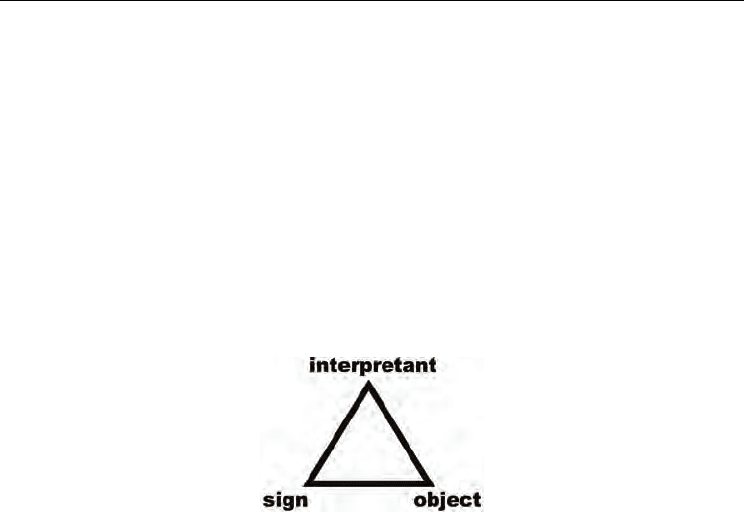
Implicit Estimation of Another’s Intention Based on Modular Reinforcement Learning
383
semiotics is that the relationship between “sign” and “object” is not fixed. The relationship
can be dynamically changing. The relationship simply depends on the “interpretant.” The
dynamic process by which a sign represents an object mediated by an interpretant is called
“semiosis.” Peirce’s semiotics is thoroughly constructed from the viewpoint of an
interpreter. In the framework of Peirce’s semiotics, the third element, “interpretant,” plays
an essential role in communication. In Shannon’s communication model, one premise is that
a shared code table is required. However, an autonomous agent cannot observe other
agents’ internal goals or code table. In contrast, Peirce’s semiosis does not require such a
premise. Semiosis is a phenomenon that emerges inside of an autonomous agent. The
participants in a communication must create meaning from incoming signs based on their
physical and social experience. Such an individual learning process is considered to
supplement symbolic communication. However, semiosis requires autonomous agents to
have sufficient adaptability and capability to create meanings from superficial meaningless
signs.
Fig. 2. Semiotic triad
In a human collaborative task, a human participant becomes able to distinguish several
situations, which are modified by another’s changing intentions. In such a case, the kind of
policy the participant should follow in each situation is not clear beforehand. However, if
the team continues to collaborate through trial and error, some kind of shared rules will be
formed as a kind of habit of the team, and a follwer on the team becomes able to perform
adequately by referring to the situation and the habit. This process corresponds to
“semiosis” in Peirce’s semiotics. Here, “sign,” “object,” and “interpretant” correspond to a
“situation,” “the leader’s intention,” and “acquired rule” or “the follower’s action,”
respectively.
An important point in this scenario is that the “situation” has no meaning before the
follower distinguishes situation, performs adequately, and a tacit rule is established
between the two agents.
In this chapter, we describe candidates for computational communication models, which are
based on Peirce’s semiosis.
2.2 Estimation of another’s intention
Roughly speaking, we assume there are two ways in which we estimate another’s intention.
Here, we explain the difference between the two ways of estimating another’s intention.
For illustrative purposes, we assume that there is a leader in an organization who makes
decisions. The leader makes decisions to direct the team, and followers play their roles
based on the decision.
In such a case, the leader communicates his/her intention to the follwers, and followers in
the organization have to estimate a leading agent’s intention to cope with cooperative tasks.
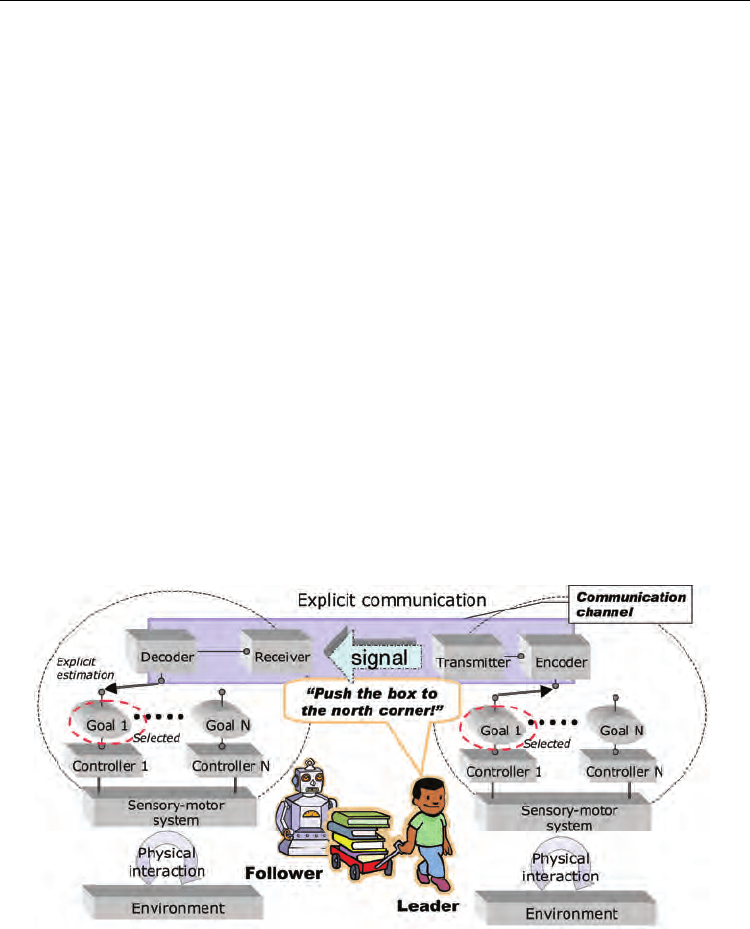
Machine Learning
384
The communication and the estimation of another’s intention are different aspects of the
same phenomenon, as we described above. How can followers members estimate the
leader’s intention? This is the problem.
Here, we take two kinds of estimation of another’s intention into consideration. One is
“explicit estimation,” and the other is “implicit estimation.”
2.2.1 Explicit estimation of another’s intention
One solution for communicating one’s intention to another person is to express one’s
intention directly with predefined signals, e.g., by pointing to the goal and by commanding
the other person to act. The method of communication requires a shared symbolic system as
a basic premise. The symbolic system is often called a code table. If the symbolic system
used in this communication must be completely shared by the participants in the
cooperativetask environment, a participant who receives a message understands exactly
what the person transmitting the message wants to do. The receiver of the message can
estimate the sender’s intentions based on externalized signs. We call this process the
“explicit estimation” because the intention of the leader is explicitly expressed as
externalized signals. In this communication model, both agents have to share a predefined
code table before the tasks. In the explicit estimation model, the accuracy of the
communication is measured by the coincidence between the transmitted message and the
receiver’s interpretation of the sender’s message, which is obtained by decoding the
incoming signal utilizing the shared code table. The process of estimating another’s
intention in a collaborative task is shown in Figure 3 schematically. A leader and a follower
carry a truck collaboratively. How can the follower estimate the leader’s goal using explicit
estimation when the leader changes his goal?
Fig. 3. explicit estimation
First, the leader agent changes his goal. In the explicit estimation scheme, this seems like a
natural framework of communication. After Shannon formulated “communication”
mathematically, many sociologists and computer scientists have described “communication”
as above. However, the communication model based on explicit estimation of another’s
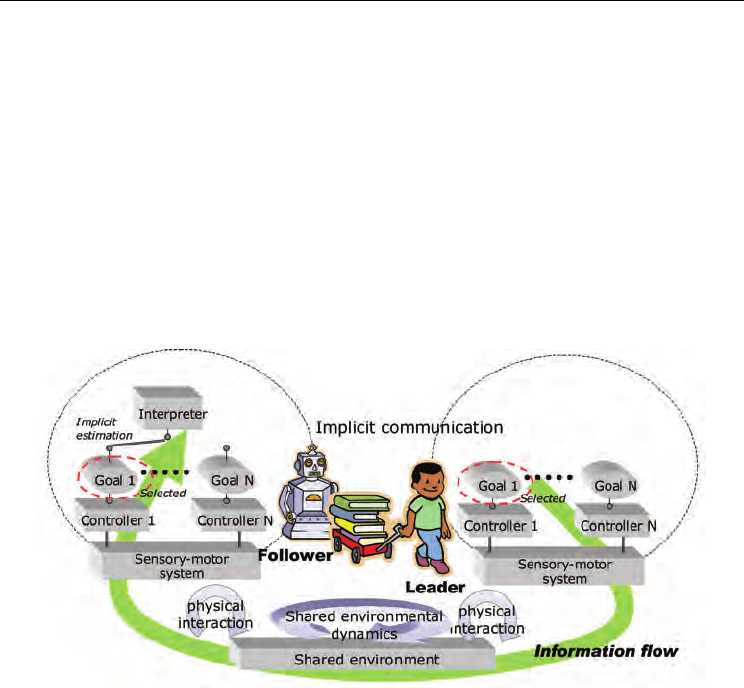
Implicit Estimation of Another’s Intention Based on Modular Reinforcement Learning
385
intention has two shortcomings. One is that the method of sharing the code table between
the two agetns is unknown. If we consider the two agents to be autonomous, neither agent
can observe the other agent’s internal goals and code table. Therefore, neither agent can
utilize a “teacher signal” as feedback of its interpretation to upgrade its code table. The
second shortcoming is that the leader agent has to display his intention whenever he
changes his goal. These are two problems of explicit estimation of another’s intention.
In contrast, when we review what we do in collaborative tasks, we find that we do not
always send verbal messages representing our intention to our collaborators. We sometimes
execute a collaborative task without saying anything. In this case, the leader’s intention is
not transmitted to the follower by sending the explicit linguistic sign but through the shared
environmental dynamics implicitly. Explicit estimation of another’s intention is not the only
way of communication. To complement or to support the explicit estimation, implicit
estimation is necessary.
Fig. 4. Implicit communication
2.2.2 Implicit estimation of another’s intention
People occasionally undertake collaborative tasks without saying anything. Even if a leader
says nothing to members of his organization, they can often perform the task by estimating
the leader’s intentions on the basis of their observation. We call such an estimation process
“implicit estimation” of another’s intention. However, if there were no pathways through
which information about the leader’s intention goes to the followers, the followers could
never estimate the leader’s intention. One reason followers can estimate the leader’s
intention is that the action and sensation of the followers are causally related to the leader’s
intentions.
In other words, sensations a participating agent has after he/she performs actions are
affected by the leader’s way of acting and another agents’ ways of acting. Therefore,
subjective environmental dynamics for a participating agent are causally affected by the
leader’s intention because other agents are assumed to behave based on the leader’s
intention.

Machine Learning
386
We assume none of the members can observe any information except for their own sensory-
motor information. However, they can estimate the leader’s intentions. We call this process
“implicit estimation.” Implicit estimation is achieved by watching how the agent’s sensation
changes. In control tasks, an agent usually observes state variables.
In what follows, we assume that an agent obtains state variables, e.g., position, velocity, and
angle. State variables are usually considered to be objectives to be controlled in many
control tasks. However, in implicit communication, state variables also become information
media of another agent’s intention. An participating agent can estimate another’s intention
by observing changes in state variables. The information goes through their shared
dynamics.
The process of implicit estimation of another’s intention is showen in Figure 4,
schematically. First, the leader changes his goal. When the leader’s goal has changed, his
controller, which produces his behavior, is switched. That, of course, affects physical
dynamics of the dynamical system shared between the leader and the follower. If a
participating agent has a state predictor, he will become aware of the qualitative change in
the shared dynamics because his prediction of the state value collapses If physical dynamics
are stable, he can predict his state variables consistently. If the follower agent notices the
change in subjective physical dynamics, the follower can notice the change in the leader’s
intention based on the causal relationship between the leader’s intention and his facing
dynamical system.
Therefore, the capability to predict state variables seems to be required for physical skills
and social skills. This scenario suggests the process of learning physical skills to control the
target system and the method to communicate with the partner agent might be quite similar
in such cooperative tasks.
3. Multiple internal models
Our computational model of implicit estimation of another’s intention is based on modular
reinforcement learning architecture including multiple internal models. To achieve implicit
estimation of another’s intention described in the previous section, an agent must have a
learning architecture that includes state predictors. We focus on multiple internal models as
neural architectures that achieve such an adaptive capability.
3.1 Multiple internal models and social adaptability
Relationships between the human brain’s social capability and physical capability are
commanding interest. From the viewpoint of computational neuroscience, Wolpert et al. [17,
3] suggested that MOSAIC, which is a modular learning architecture representing a part of
the human central nervous system (CNS), acquires multiple internal models that play an
essential role in adapting to the physical dynamic environment as well as other roles. We
regard this as a candidate for a brain function that connects human physical capability and
social capability. An internal model is a learning architecture that predicts the state
transition of the environment or other target system. This is a belief that a person can
operate his/her body and his/her grasping tool by utilizing an obtained internal model[16].
The internal model is acquired in the cerebellum through interactions. The learning system
of internal models is considered to be a kind of schema that assimilates exterior dynamics
and accommodates the internal memory system, i.e., internal model. If a person encounters
various kinds of environments and/or tools, which have different dynamical properties, the

Implicit Estimation of Another’s Intention Based on Modular Reinforcement Learning
387
human brain needs to differentiate them and acquire several internal models. However,
segmentation of dynamics is not given a priori. Therefore, a learning architecture
representing multiple internal models should generate and learn internal models, and
recognize changes in physical dynamics in its facing environment at the same time. To
describe such a learning system, several computational models have been proposed, e.g.,
MPFIM [17], the mixture of RNNs[10], RNNPB[9], and the schema model [13]. Most of them
are comprised of several learning predictors. The learning architecture switches the
predictors and accommodates them through interactions with the environment. Such a
learning architecture is often called a modular learning system. The RNNPB is not a
modular learning system. Tani insisted internal models should be obtained in a single
neural network in a distributed way[9]. In most modular learning architecture, a Bayesian
rule is used to calculate the posterior probability in which a current predictor is selected. In
contrast, the schema model [13] is a modular learning architecture that does not use a
Bayesian rule but hypothesis-testing theory. At the moment, multiple internal models are
usually considered to be a learning system for an autonomous system to cope with a
physically dynamic environment. Meanwhile, Wolpert et al. addressed a hypothesis that a
person utilizes multiple internal models to estimate another’s intention from the observation
of another’s movement. Although these internal models described in the hypothesis seem to
add a slightly different feature to the original definition of an internal model, interestingly,
the hypothesis tries to connect neural architectures for physical adaptability and social
adaptability. Doya et al. [1] proposed a modular learning architecture that enables robots to
estimate another’s intention and to communicate with each other in a reinforcement
learning task.
In addition, when a person performs a collaborative task with others, one can notice changes
in another agent’s intention by recognizing the change in his/her facing dynamical system
without any direct observation of the other agent’s movement. This means multiple internal
models enable an agent to notice changes in another agent’s intention. This usage of
multiple internal models does not require adding any features to the original definition of
multiple internal models.
3.2 Implicit estimation of another’s intention based on multiple internal models
“Intention” in everyday language denotes a number of meanings. Therefore, a perfect
computational definition of “intention” is impossible. In this chapter, we simply consider an
“intention” as a goal the agent is trying to achieve. In the framework of reinforcement
learning, an agent’s goal is represented by a reward function. Therefore, an agent who has
several intentions has several internal goals, i.e., several internal reward functions, G
m
. If an
internal reward function, G
m
, is selected, a policy, u
m
, is selected and modified to maximize
the cumulative future internal reward through interactions with the task environment.
In the following, we assume that the collaborative task involves two agents. The system is
described as
(1)
(2)
(3)
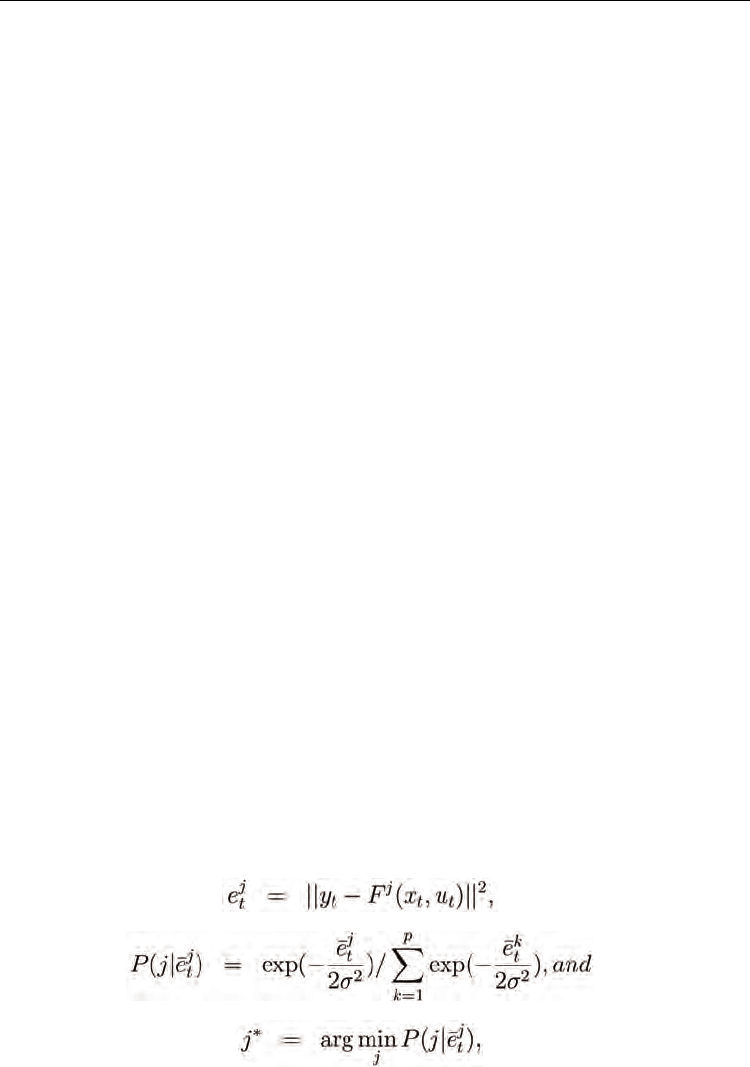
Machine Learning
388
Here, x is a state variable, u
i
is the i-th agent’s motor output, and n is a noise term. We
assumed that an agent would not be able to observe another agent’s motor output directly.
In such cases, environmental dynamics seem to be Eq. 3 to the first agent. If the second agent
changes its policy, environmental dynamics for the first agent change. Therefore, in a
physically stationary environment, the first agent can establish that the second agent has
changed its intention by noticing changes in environmental dynamics.
The discussion can be summarized as follows. If physical environmental dynamics, f, is
fixed, agents who have multiple internal models can detect changes in another agent’s
intentions by detecting changes in subjective environmental dynamics, F. The computational
process is equal to the process by which an agent detects changes in the original physical
dynamics.
We define “situation” as “how state variable x and motor output u change observed output
y.” In this case, a change in an agent’s intentions leads to a change in the subjective situation
of another agent. By utilizing multiple internal models, an agent is expected to differentiate
situations and execute adequate actions. In the next section, we describe a concrete modular
reinforcement learning architecture named Situation-Sensitive Reinforcement Learning
(SSRL).
4. Situation-sensitive reinforcement learning architecture
It is important for autonomous agents to accumulate the results of adaptation to various
environments to cope with dynamically changing environments. Acquired concepts,
models, and policies should be stored for similar situations that are expected to occur in the
near future. Not only learning a certain behavior and/or a certain model, but also the
obtained behaviors, policies, and models is essential to describe such a learning process.
Many modular learning architectures [7, 4] and hierarchical learning architectures [10, 8]
have been proposed to describe this kind of learning process. This section introduces such a
modular-learning architecture called the situation-sensitive reinforcement learning
architecture (SSRL). This enables an autonomous agent to distinguish changes the agent is
facing in situations, and to infer the partner agent’s intentions without any teacher signals
from the partner.
4.1 Discrimination of intentions based on changes in dynamics
Fig. 5 is an overview of SSRL. SSRL has several state predictors, F
m
, representing situations
and internal goals, G
m
, representing intentions. Each state predictor F
m
corresponds to each
situation.
(4)
(5)
(6)
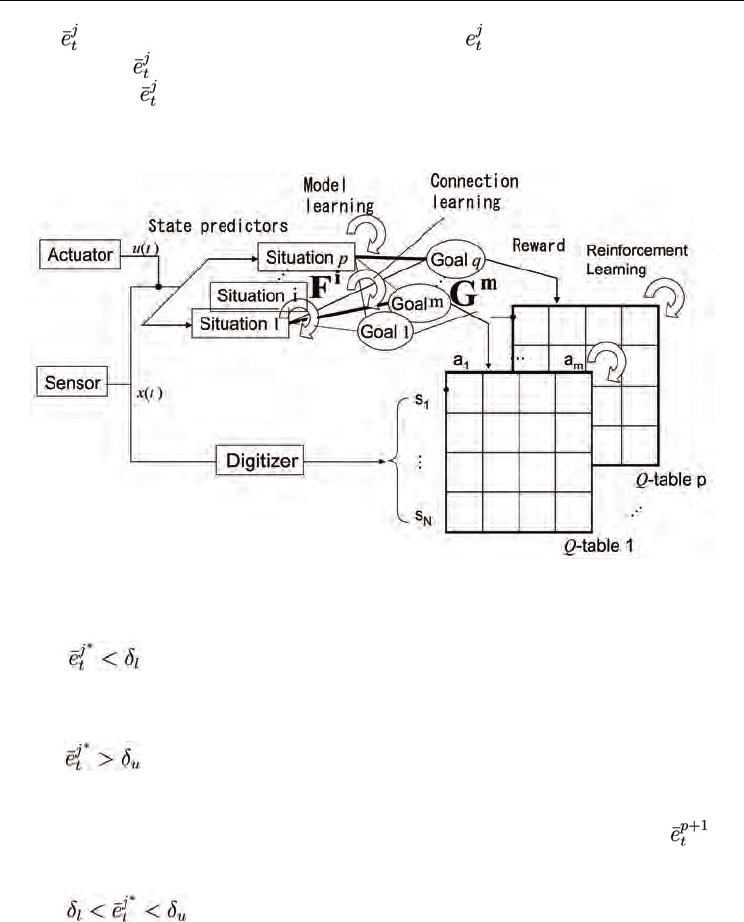
Implicit Estimation of Another’s Intention Based on Modular Reinforcement Learning
389
where
is the temporal average of the prediction error,
, of the j-th state
predictor, F
j
. If
averaged error
has a normal distribution and the system
dynamics is F
j
, the posterior
probability, P(j|
), can be defined based on
the Bayesian framework above under the
condition that there is no other
information. If there are no adequate state predictors in
SSRL, the SSRL allocates one more state predictor based on hypothesis-testing theory [13].
Fig. 5. Situation-Sensitive Reinforcement Learning architecture
We model the state predictors by using locally linear predictors, and we don’t estimate the
standard deviation σ . The updating rule are switched based on hypothesis testing.
Case 1:
In this case, the learning system considers that incoming sample data are normal
samples for the existing predictors, decides the curret situation j*, and update the
corresponding function F
j*
by using assimilated samples.
Case 2:
In this case, the learning system considers that incoming sample data are outliers for the
existing predictors, and prepare a new fnction F
p+1
. It decides the curret situation j
p+1
.
However, the new predictor is considered as a exeptional state predictor until < δ
l
.
If the predictor’s averaged error reaches under δ
l
, the function F
p+1
is taken into a list of
existing predictors, and p ← p + 1.
Case 3:
In this case, the system take no account of the incoming sample.
This is an intermediate method for the MOSAIC model [17, 15], which is based on the Basian
framework, and the schema model [13], which is based on hypothesis-testing theory. SSRL
detects the current situation based on Eq. 6. During this an adequate state predictor is
selected and assimilates the incoming experiences; SSRL acquires the state predictors by
ridge regression based on the assimilated experiences.
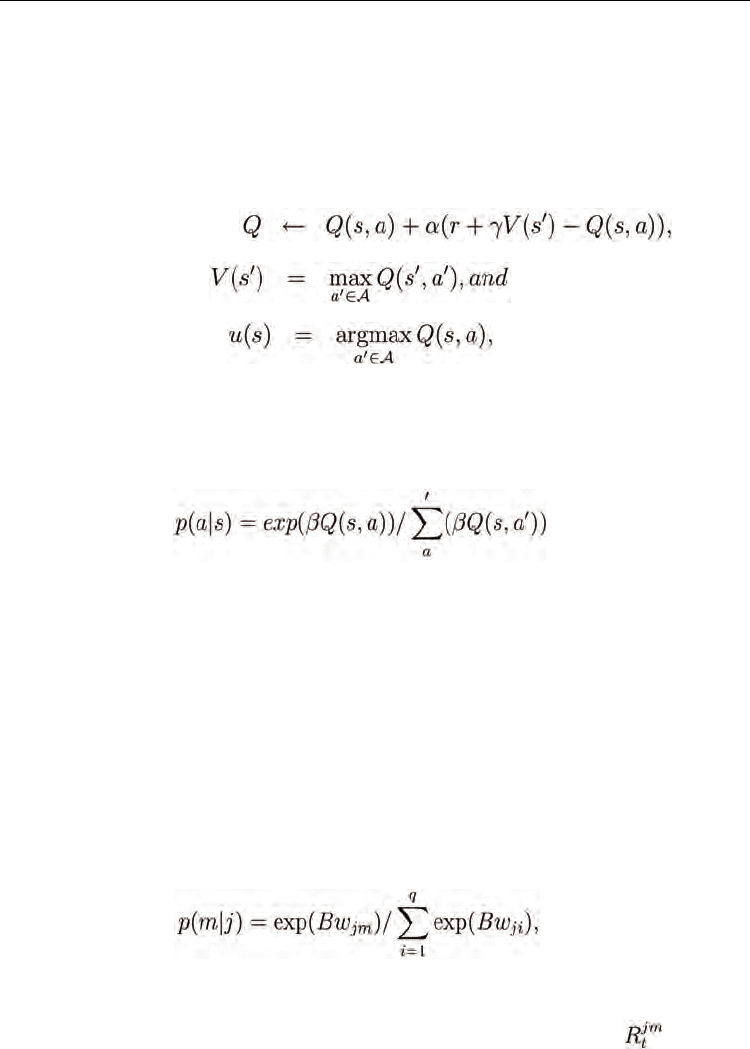
Machine Learning
390
4.2 Reinforcement learning
Each policy corresponding to a goal is acquired by using reinforcement learning [6]. SSRL
uses Q-Learning [14] in this paper. This method can be used to estimate the state-action
value function, Q(s, a), through interactions with the agent’s environment. The optimal
state-action value function directly gives the optimal policy. When we define S as a set of
state variables and A as a set of motor outputs, and we assume the environment consists of
a Markov decision process, the algorithm for Q-learning is described as
(7)
(8)
where s ∈ S is a state variable, a ∈A is a motor output, r(s, a) is a reward, and s’ is a state
variable at the next time step. In these equations, is the learning rate and γ is a discount
factor. After an adequate Q is acquired,the agent can utilize an optimal policy, u, as in Eq. 8.
Boltzmann selection is employed during the learning phase.
(9)
4.3 Switching architecture of internal goals
An agent can detect changes in the other agent’s intentions by distinguishing between
situations he/she faces. However, the goals themselves cannot be estimated even if
switching between several goals can be detected. Here, we describe a learning method,
which enables an agent to estimate the another’s intentions implicitly. The method requires
three assumptions to be made.
A1 Physical environmental dynamics f do not change.
A2 Every internal goal is equally difficult to achieve.
A3 The leader agent always selects each optimal policy for each intention.
The mathematical explanation for these assumptions will be described in the next section.
We employes Boltzmann selection for internal goal switch. The rule to select the internal
goals are described as
(10)
where p(m|j) is the probability that G
m
will be selected under situation, F
j
, and B is the
inverse temperature. The network connection, w
jm
, between the current situation, F
j
, and
the current internal goal, G
m
, is modified by the sum of the obtained reward, , during a
certain period during the t-th trial, i.e.,
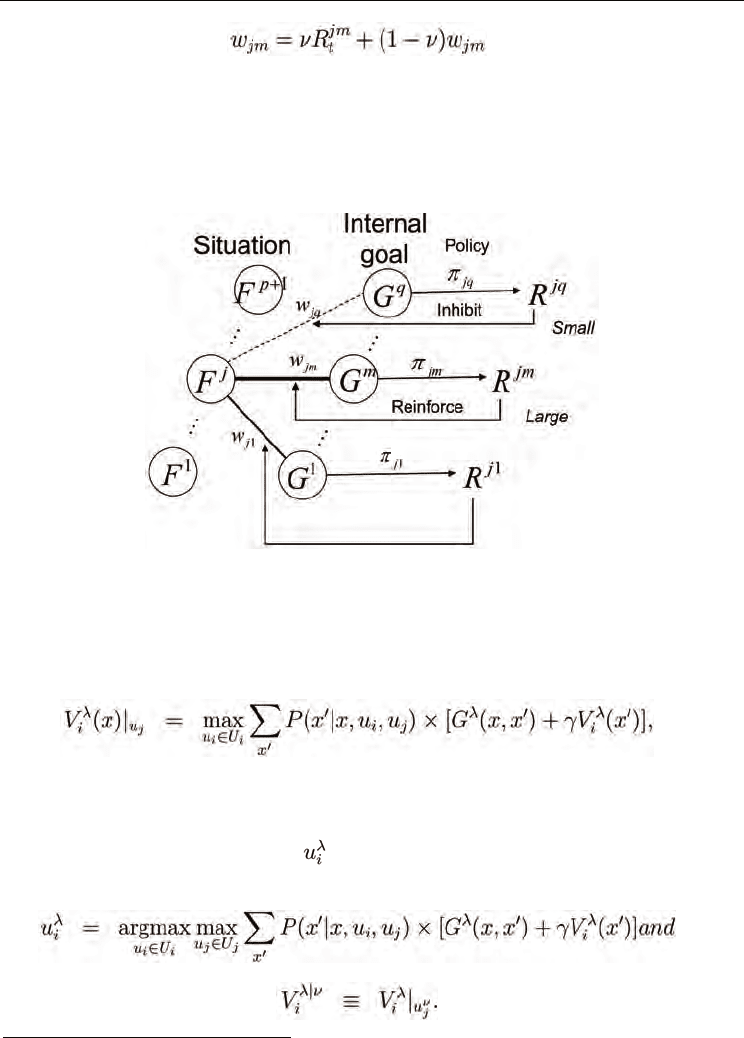
Implicit Estimation of Another’s Intention Based on Modular Reinforcement Learning
391
(11)
Here, ν is the learning rate of the internal goal switching module. Eq. 11 shows that
connection w
jm
becomes strong if internal goal G
m
is more easy to accomplish when the
situation is F
j
. Eq. 10 shows that an internal goal is more likely to be selected if its network
connection is stronger than the other’s. The abstract figure for the switching module is
shown in Fig. 6. If the learning process for the switching architecture of internal goals is
preceded and converged, a certain internal goal corresponding to a situation is selected.
Fig. 6. Internal goal switching module
4.4 Mathematical basis for internal goal switching module
This section provides the mathematical basis for the learning rule ofr the implicit
communication. First, the Bellman equation for the i-th (i = 1, 2) agent of a system involving
two agents are described as
1
.
(12)
where G
λ
is a reward function for the λ-th goal, u
i
is the i-th agent’s motor output, and x’ is
the x in the next step. G
λ
in this framework is not assumed to have motor outputs as
variables of the function. The optimal value function for the i-th agent depends on the other
agent’s policy, u
j
. Here, we define as the i-th agent’s policy that maximizes the j-th
agent’s maximized value function whose goal is G
λ
.
(13)
(14)
1
In this section, we have assumed i ≠ j without making any remarks.
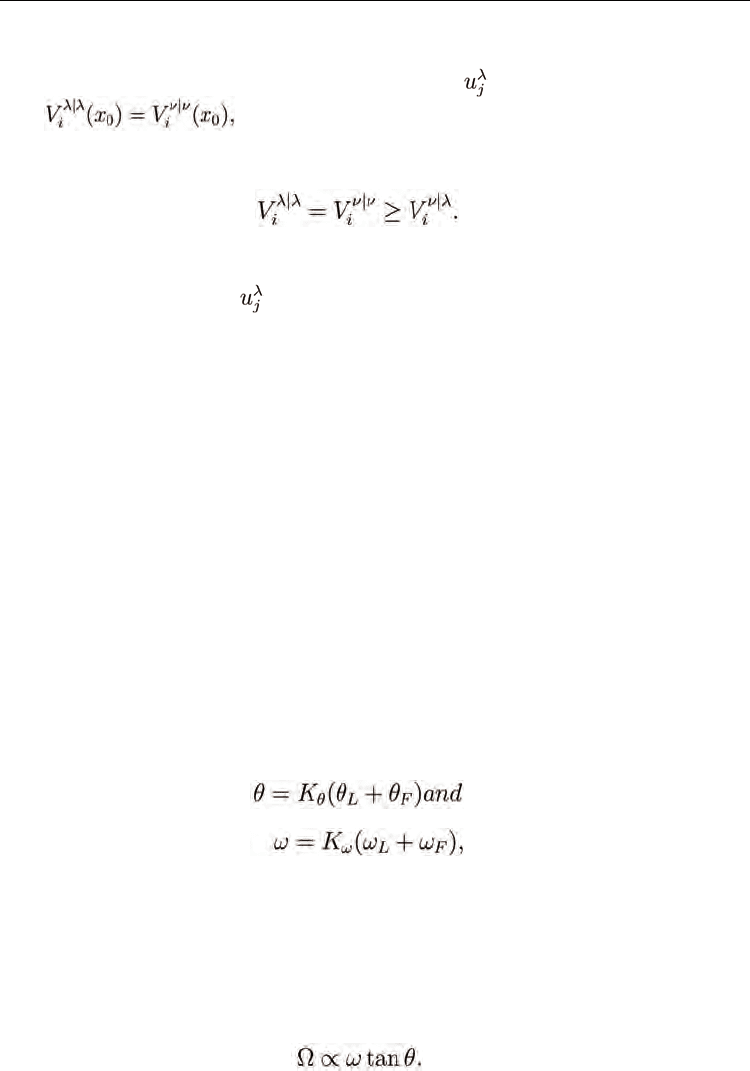
Machine Learning
392
The assumptions, A2 and A3, we made in the previous section can be translated into the
following,
A’2 : We assumed the j-th agent would use the controller, , and
A’3 :
where x
0
is the initial point of the task. The following relationship can easily be derived from
the definition.
(15)
Therefore, the i-th agent’s internal goal becomes the same as j-th agent’s goal, if the i-th
agent select a reward function that maximizes the value function under the condition that
the j-th agent uses controller
. When the initial point is not fixed, V
i
(x
0
) is substituted by
the averaged cumulative sum of rewards the i−th agent obtains, who starts the task around
the initial point, x
0
. This leads us to the algorithm eq.11.
5. Experiment
We evaluate SSRL in this section. To fulfill all the assumptions made in Section 4 completely
is difficult in a realistic task environment. The task described in this section roughly satisfies
the assumptions, A’2 and A’3.
5.1 Conditions
We applied the proposed method to the truck-pushing task shown in Fig. 7. Two agents in
the task environment, “Leader” and “Follower,”cooperatively push a truck to various
locations. Both agents can adjust the truck’s velocity and the angle of the handle. However, a
single agent cannot achieve the task alone because its control force is limited. In addition,
the Leader has all fixed policies for all sub-goals beforehand, and holds a stake in deciding
the next goal. However, the agents cannot communicate with each other. Therefore, the
agents cannot “explicitly” communicate their intentions. The Follower perceives situation F
j
by using SSRL, changes its internal goal G
m
based on the situation, and learns how to
achieve the collaborative task. The two agents output the angle of the handle, θ
L
, θ
F
, and the
wheel’s rotating speed, ω
L
, ω
F
. Here,the final motor output to the truck, θ, ω, is defined as
(16)
(17)
where K
θ
and K
ω
are the gain parameters of the truck. K
θ
and K
ω
were set to 0.5 in this
experiment. The Leader’s controller was designed to approximately satisfy the assumptions
in Section 3. The controller in this experiment was a simple PD controller. The Follower’s
state, s, was defined as s = [ρ, ]. The state space was digitized into 10 × 8 parts. The action
space was defined as θ
F
= {−π/4,−π/8, 0, π/8, π/4} and ω
F
= {0.0, 3.0}. As a result of the two
agents’ actions, the truck’s angular velocity, Ω, was observed by the Follower agent. Ω, θ,
and ω have a relationship of
(18)
